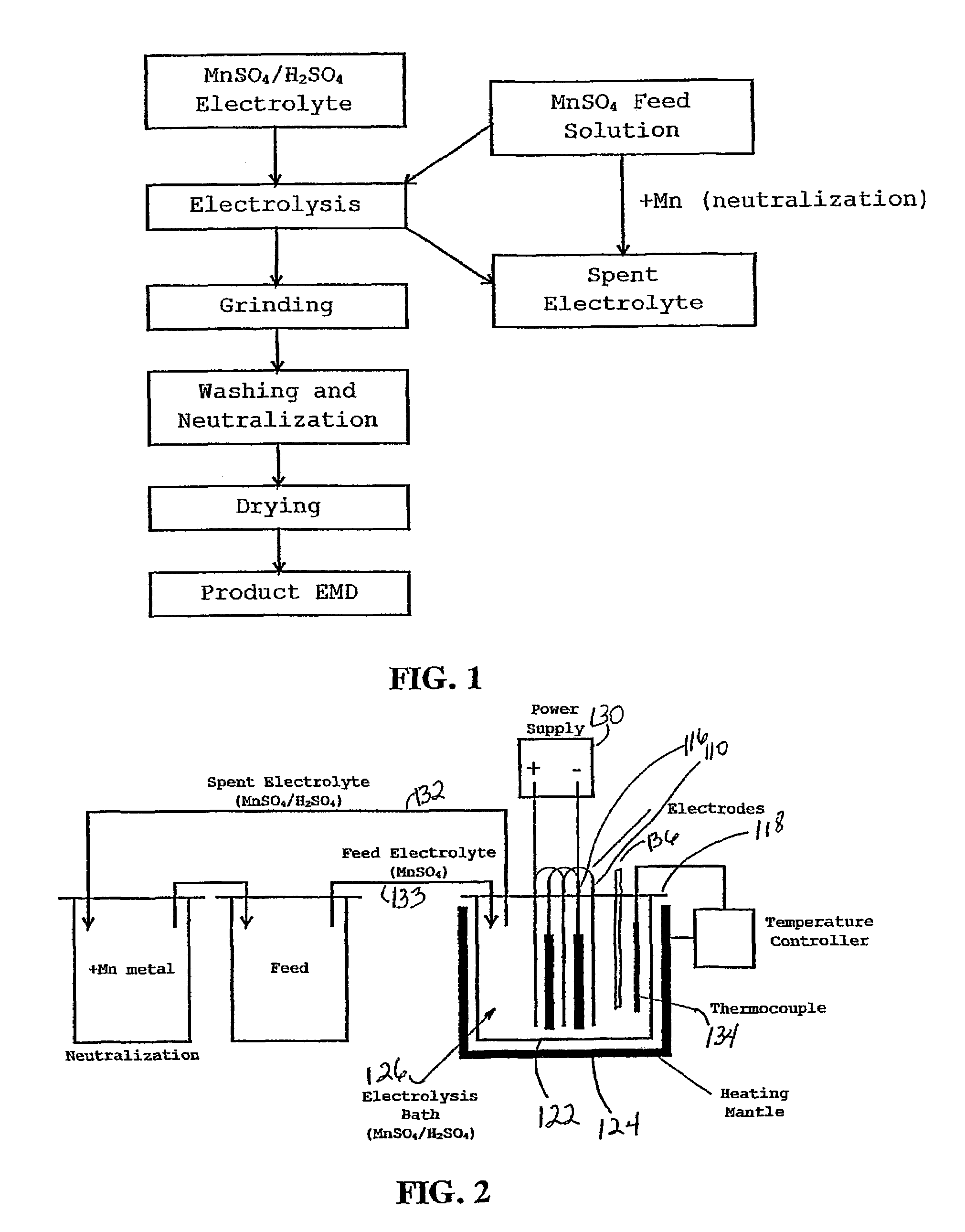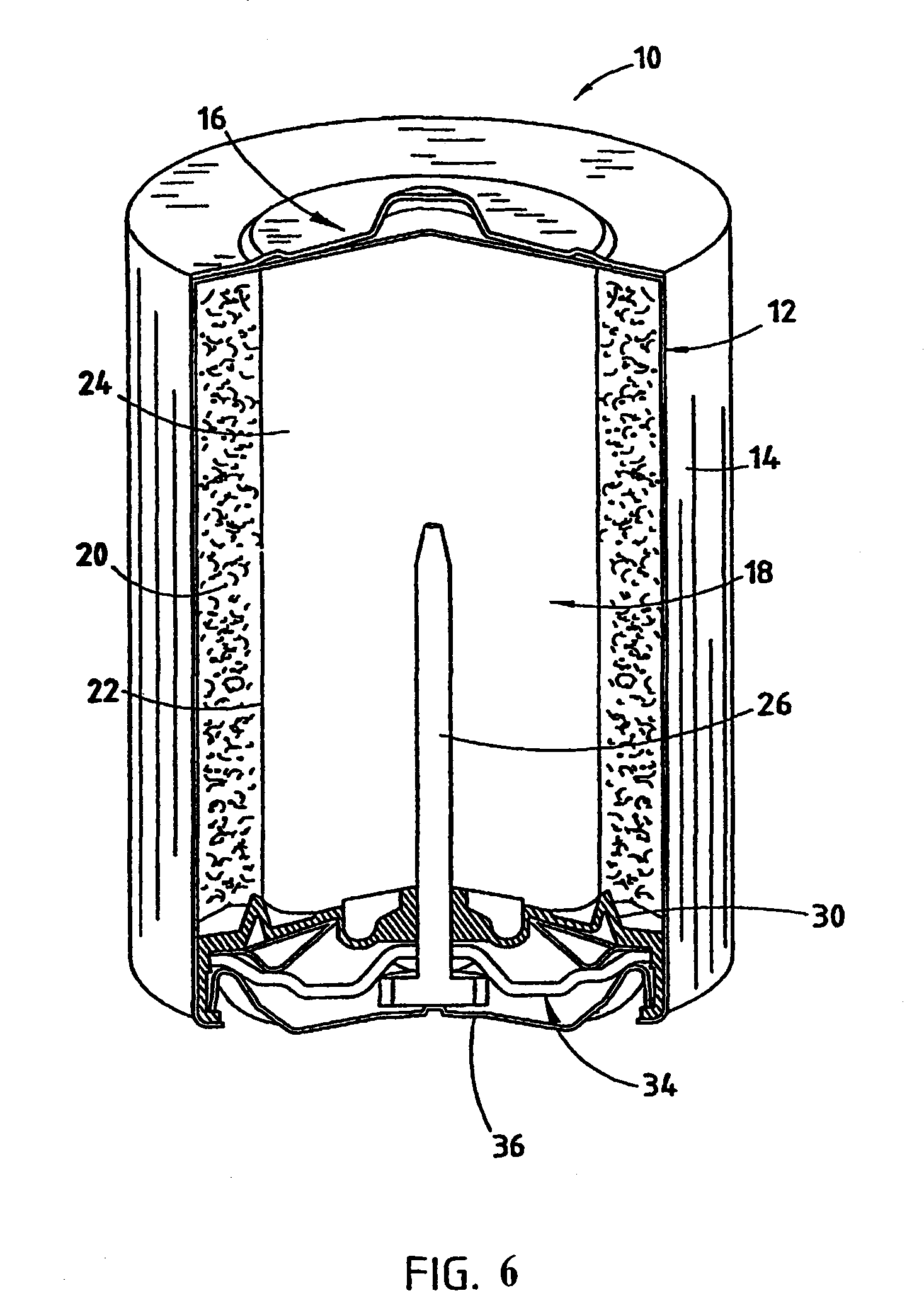Doped manganese dioxides
a technology of manganese dioxide and electrodes, which is applied in the field of batteries, can solve the problems that manganese dioxide is not generally employed in alkaline or lithium cells, and achieve the effect of improving electrochemical performan
- Summary
- Abstract
- Description
- Claims
- Application Information
AI Technical Summary
Benefits of technology
Problems solved by technology
Method used
Image
Examples
examples of emd manufacture
Example 1
Doped EMD; e.g., Mg2+ Doped EMD
[0066]In this example the apparatus used was exactly the same as that described above and shown in FIGS. 2-5. Sufficient MgSO4 was added to the cell electrolyte (aqueous MnSO4 / H2 SO4) to make the concentration of Mg2+ 1000 ppm. Also, sufficient MgSO4 was added to the feed solution (aqueous MnSO4) to make the concentration of Mg2+ 1000 ppm. Electrolysis leading to XMD deposition was carried out as described previously.
example 2
Doped EMD; e.g., Mg2+ Doped EMD
[0067]This method is a more controlled alternative to that described in Example 1. The apparatus necessary for this example is similar to that used to prepare non-doped EMD, with the addition of another pump to be used for the addition of dopant to the electrolysis bath. Also necessary for this technique is a method for measuring the concentration of dopant in the electrolysis bath. Sufficient MgSO4 was added to the cell electrolyte prior to electrolysis to make the concentration of Mg2+ 5000 ppm. The feed solution was the same as that used when non-doped EMD was prepared. Another solution of 1000 ppm Mg2+ (from MgSO4) was also prepared. Electrolysis leading to XMD deposition was carried out similar to that described previously. The concentration of Mg2+ in the electrolysis bath was monitored continuously and fed back to the pump controlling MgSO4 solution addition. Based on the feedback information MgSO4 solution flow into the electrolysis cell was ei...
example 3
Doped EMD; e.g., Nb5+ Doped EMD (Nb(n-butoxide)5)
[0068]In this case NB2(SO4)5, or similar chloride or nitrate salt, was not available so an alternative approach had to be developed. The electrolysis cell was prepared as described previously and in Example 2, except that for this example no dopant was included in the electrolyte and the dopant solution contained 5000 ppm of Nb5+ (from Nb(n-butoxide)5) in methanol. This solution was pumped into the electrolysis cell just prior to electrolysis to raise the Nb5+ level in the electrolyte to 1000 ppm, and was continually added to the electrolysis bath after the onset of electrolysis to maintain 1000 ppm of Nb5+ in the cell. A benefit of this method of dopant introduction is that the methanol solvent evaporates immediately from the electrolysis cell (90-100° C.) leaving Nb5+ in solution. This technique was used for Ge4+, Nb5+ and Ti4+ dopant addition.
PUM
| Property | Measurement | Unit |
|---|---|---|
| weight percent | aaaaa | aaaaa |
| temperature | aaaaa | aaaaa |
| temperatures | aaaaa | aaaaa |
Abstract
Description
Claims
Application Information
 Login to View More
Login to View More - R&D
- Intellectual Property
- Life Sciences
- Materials
- Tech Scout
- Unparalleled Data Quality
- Higher Quality Content
- 60% Fewer Hallucinations
Browse by: Latest US Patents, China's latest patents, Technical Efficacy Thesaurus, Application Domain, Technology Topic, Popular Technical Reports.
© 2025 PatSnap. All rights reserved.Legal|Privacy policy|Modern Slavery Act Transparency Statement|Sitemap|About US| Contact US: help@patsnap.com



